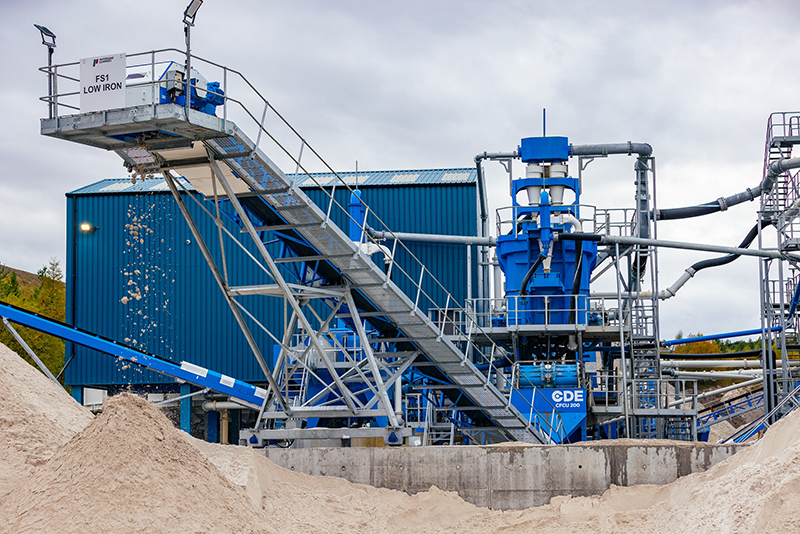FIFE Silica Sands has hailed the performance of the firm’s silica glass sand plant, after teaming up with CDE to commission the 210 tonnes per hour plant to meet growing market demand.
Fife Silica Sands, located at Burrowine Moor Quarry, near Alloa, is owned and operated by Paterson Quarries. Paterson operates five sites throughout Scotland, supplying materials including concrete, specialist sand and recycled aggregates. The firm acquired Fife Silica Sands in 2002.
CDE has been working with Paterson Quarries for over 15 years, having first partnered in 2011 on a modular sand washing plant.
Tom Paterson, MD of Paterson Quarries, said, “From previous projects and years of experience working together, we knew that CDE would be the right choice. Our ultimate goal was to deliver a top-quality silica sand to customers across the UK and Ireland. CDE’s team meticulously tested material in their lab to get a true understanding of our expectations and the materials we wanted to produce, so that they could design the right plant for us.”
Chris McKeown, director of customer solutions at CDE, added, “Throughout all the projects we’ve delivered for Paterson Quarries, the customer’s input has been critical within this process, and we try to incorporate all the requests into the design of the plant. This included visiting multiple reference sites, testing of the material in our lab, and flying over for inward visits with our design team in-house.”
The glass industry is the largest end-user of silica sand production, followed by sands for foundry, hydraulic fracturing, filtration, and abrasives applications. CDE explained that the construction market, rising automotive production, and technological advancements such as smart phones, televisions, solar control glazing for automotive and building glasses, lightweight glazing glass, and advanced nanotechnology in flat glass are all increasing demand for high-grade silica.
CDE designed and engineered a 210tph sand washing solution which was commissioned in February 2024. The solution comprises of the CDE P2-108 prograde screen which takes in the material, conditions it and prepares it for the downstream processes. The prograde screen generates three products: +7mm, 3-7mm and a 0-3mm. Five F1-64 Infinity fine screens were added to boost separation of the minus 0.6mm material from the 0-3mm generated by the prograde screen.
The plant is also equipped with ShearClean Attrition Cells, Spiral Separators and two Counter Flow Classification Units (CFCU).
The paddle design of the ShearClean Attrition Cells is designed to ensure consistent scrubbing of all material. The Spiral Separators facilitate removal of heavy contaminants from the sand stream, while the two CFCU units are used to remove lightweight material and the 0-150 micron fine sand.
CDE incorporated multiple sets of High-Intensity Magnetic Filters into the process, which are used for reduction of the ferrous contaminants from the feed stream.
For desliming and dewatering of the sand, three EvoWash sand washing systems are used, one for high grade glass sand, one for low grade glass sand, and the third for fines. The systems contain modular hydro cyclone technology, which CDE said allows for ‘unparalleled’ control of silt cut points.
The water in the process is recycled by the CDE AquaCycle, which enables Fife Silica Sands to recover 90% of the process water to be recycled for immediate recirculation.
Tom Paterson added, “From an environmental point of view, this plant is a real win for us, as there is less waste and we’re recovering more. We have a direct wire to a wind turbine, so we have all the needs for this plant from renewable energy when the wind blows.”
The wash plant operates 24 hours a day from Monday to Friday. CDE installed its SmartTech plant management app. Sensors fitted to the plant provide up to 300 data points and continuously stream real-time performance reports. Fife Silica Sands can monitor input feed rates, the hopper speed, thickener and water tank levels remotely.
With this sand washing solution, Fife Silica Sands is able to produce seven products to supply the market. The two glass sand products are the main outputs from the plant and there are a number of other fractions produced which are used for applications including sports sands and construction aggregates.
Tom Paterson said, “We’re supplying thousands of tonnes of specialist sand weekly to large glass manufacturers across the UK, who are producing the highest quality glass, as well as supplying construction markets and providing feedstock for asphalt production, render sands and ready mixed concrete, high quality USGA sands for top dressing, golf course construction and bunker sands along with horse riding arenas.
“This is a new and different approach for us and we’re getting a much higher yield from every tonne of product, and far in excess of our expectations. We have one glass customer who has signed up to work with us for 20 years, which is a testament to the quality of the products we’re supplying.”
Chris McKeown concluded, “Across our industry tonnes per hour is a common metric used to describe the performance of a plant. But ultimately, the return on investment of a plant like this is built on achieving that tonnage over an extended period of time. So, in CDE, the key metrics for us are tonnes per week, tonnes per month, tonnes per year, over many years.”












